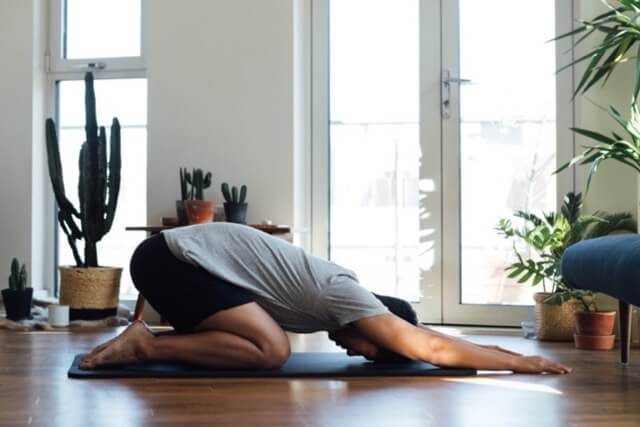Author: Randeep Singh / go to all articles on Yoga cure
Yoga poses for headache:
Head ache is a condition in which sensation of pain is experienced within the region of the head.
The intensity of pain experienced in the head can vary from occasional milder throbs of ache to excruciatingly debilitating migraines which can last for days and weeks together. The severity of the headache mainly depends upon the cause that has triggered it. Yoga poses for headache work at the cause level to heal it.
As per the International headache society, head aches can be primary or secondary. Primary headache is caused by any malfunction that take place within the structures or functions of the head itself; secondary headaches are a side effect , or a symptom of some other malady or disease present within the body.
Primary headaches like migraines are the result of the conditions present within the muscle, nerve or the blood vessels of the brain. Other types of primary headaches are headaches caused by the presence of psychological tension, tension headache, or headaches which occur intermittently after specific time intervals over the entire day or days together. The later are known as cluster headaches as the occur in clusters of pain episodes in the head. Conditions like a blood clot in the head, dehydration, influenza, panic attacks and stroke begets secondary headaches as their symptoms.
How does Yoga for Migraine work ?
It has been found that lack of sleep, hormonal imbalances or even family history can also cause headaches. Over use of medication meant for relieving a headache can be the cause of rebound headaches. More than 90 percent of the headaches are migraines. Migraines stand apart from other types of headaches as they are normally accompanied by the feeling of nausea, aching experienced on only one side of the head which flickers in intensity with exposure to light or sometimes even sound. Tension headaches are more of a pain of a muscles in the head region which is experiencing strain.
Imbalance in the chemicals within the brain, neurotransmitters, which are responsible for transmitting nerve impulses between the brain and the nerves is one of the known causes of migraine. Yoga provides migraine relief or headache treatment by instituting the relaxation response in the nervous system of the practitioner. This release of tension or the relaxation response is not sedatives or other medication induced but a natural response to the rhythmic stretching and contracting of the muscles associated with the yoga asanas for headache, or yoga for migraine.
How Yoga to reduce Stress Headaches work?
When the yoga poses for headache are properly coordinated with the breathing pattern, and deep breathing, it alters the mind’s response to the external stressors (can be identified with a stress test) in a positive way; the mind becomes more relaxed and steady.
Yoga provides headache relief , headache caused by stress, by stimulating the areas of the brain other than the hypothalamus ( which gets stimulated by stress signals and responds with headache) which puts the body in the restorative mode by lowering the heart rate of the practitioner. Savasana or corpse pose, Nishpandabhava are some of the yoga practices for headache treatment which form an irreplaceable part of the regime for the restorative yoga for headaches or yoga to reduce stress headaches.

How does Yoga for Cluster Headache work?
Postural anomalies especially which impact the positioning of the neck and head above the shoulders cause unnecessary strain in the muscle of this region which is experienced as constant pain in the head. Constantly being aware of one’s posture and habituating oneself with the right alignment of the head over the shoulders can release unwanted muscular tension from the temples, neck and shoulders.
Yoga for cluster headaches, also asanas forming a part of the yoga for headache treatment work by strengthening the muscles and tendons around the cervical region so that the head can be constantly held high in a neutral position in relation to the strain on the associated muscles. Yoga practices that help maintain a correct posture reduce the instances of the occurrence of headache due to a faulty posture.
Strengthening the muscles of the torso like the latissimus, and trapezius can help position the head neutral to the placement of the neck and the shoulders. This takes away any possible painful pull or constriction from within and around the region of the head. Yoga asanas for headache also work by creating space between the shoulder blades which in turn diffuses any tension in the muscles of the neck connected to the head.
Pranayama for Headache
Breathing which involves the free movement of the diaphragm helps induce relaxation in the body. One of the external indicators of the involvement of the diaphragm in breathing is that the rise and fall of the belly button is markedly visible. Regular practitioners of pranayama for headache have found that directing the air to the back of the lungs with deep breathing can induce deeper relaxation the mind-body complex.
On the contrary shallow breaths, which can be triggered by a headache already present, have been found to intensify the pain in the head. Pranayama for headache works because these breathing techniques insist on slowing and prolonging the exhalations involved. Slow and prolonged exhalations activate the parasympathetic nervous response in the body which works a painkiller for the headache.
In order to extract the maximum benefits from doing yoga for headache treatment one must understand the real essence of the yoga asana and the aspects to be considered while doing yoga poses for headache.
Yoga Remedy for Headache
Other Informative Articles….

